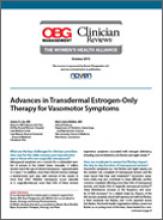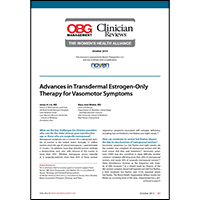User login
What are the key challenges for clinician providers who care for the older woman past reproductive age or those who are surgically menopausal? Menopausal symptoms are a concern for a substantial number of women in the United States. Annually, 11 million women reach the age of natural menopause—approximately 51.3 years.1,2 In addition, more than 500,000 women undergo a hysterectomy each year, with removal of the ovaries in more than 50%.3 Whether menopause occurs naturally or is surgically-induced, more than 85% of these women experience symptoms associated with estrogen deficiency, including, but not limited to, hot flushes and night sweats.4,5
What are the key challenges for clinician providers who care for the older woman past reproductive age or those who are surgically menopausal? Menopausal symptoms are a concern for a substantial number of women in the United States. Annually, 11 million women reach the age of natural menopause—approximately 51.3 years.1,2 In addition, more than 500,000 women undergo a hysterectomy each year, with removal of the ovaries in more than 50%.3 Whether menopause occurs naturally or is surgically-induced, more than 85% of these women experience symptoms associated with estrogen deficiency, including, but not limited to, hot flushes and night sweats.4,5
What are the key challenges for clinician providers who care for the older woman past reproductive age or those who are surgically menopausal? Menopausal symptoms are a concern for a substantial number of women in the United States. Annually, 11 million women reach the age of natural menopause—approximately 51.3 years.1,2 In addition, more than 500,000 women undergo a hysterectomy each year, with removal of the ovaries in more than 50%.3 Whether menopause occurs naturally or is surgically-induced, more than 85% of these women experience symptoms associated with estrogen deficiency, including, but not limited to, hot flushes and night sweats.4,5

